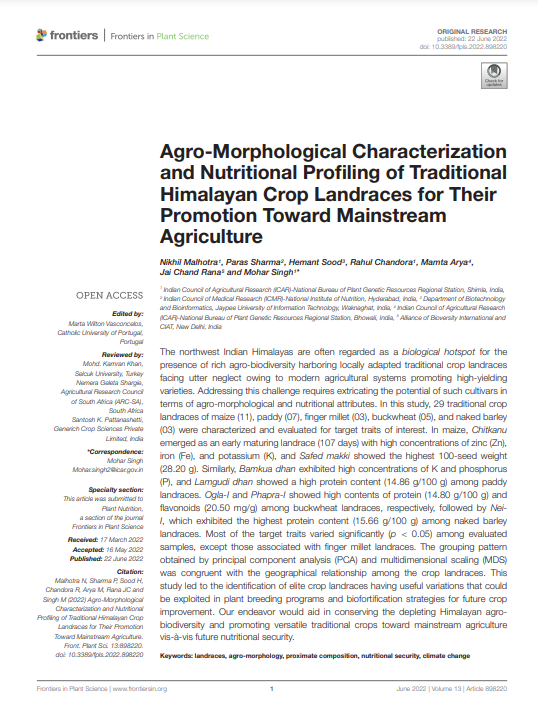The northwest Indian Himalayas are often regarded as a biological hotspot for the presence of rich agro-biodiversity harboring locally adapted traditional crop landraces facing utter neglect owing to modern agricultural systems promoting high-yielding varieties. Addressing this challenge requires extricating the potential of such cultivars in terms of agro-morphological and nutritional attributes.
In this study, 29 traditional crop landraces of maize (11), paddy (07), finger millet (03), buckwheat (05), and naked barley (03) were characterized and evaluated for target traits of interest. In maize, Chitkanu emerged as an early maturing landrace (107 days) with high concentrations of zinc (Zn), iron (Fe), and potassium (K), and Safed makki showed the highest 100-seed weight (28.20 g). Similarly, Bamkua dhan exhibited high concentrations of K and phosphorus (P), and Lamgudi dhan showed a high protein content (14.86 g/100 g) among paddy landraces. Ogla-I and Phapra-I showed high contents of protein (14.80 g/100 g) and flavonoids (20.50 mg/g) among buckwheat landraces, respectively, followed by Nei-I, which exhibited the highest protein content (15.66 g/100 g) among naked barley landraces. Most of the target traits varied significantly (p < 0.05) among evaluated samples, except those associated with finger millet landraces. The grouping pattern obtained by principal component analysis (PCA) and multidimensional scaling (MDS) was congruent with the geographical relationship among the crop landraces.
This study led to the identification of elite crop landraces having useful variations that could be exploited in plant breeding programs and biofortification strategies for future crop improvement. Our endeavor would aid in conserving the depleting Himalayan agro-biodiversity and promoting versatile traditional crops toward mainstream agriculture vis-à-vis future nutritional security.
Malhotra, N.; Sharma, P.; Sood, H.; Chandora, R.; Arya, M.; Rana, J.C.; Singh, M.

